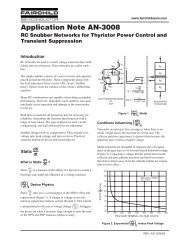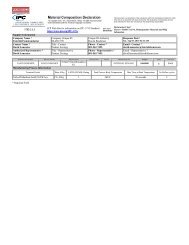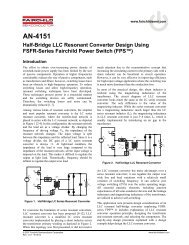AN-9732 - Fairchild Semiconductor
AN-9732 - Fairchild Semiconductor
AN-9732 - Fairchild Semiconductor
Create successful ePaper yourself
Turn your PDF publications into a flip-book with our unique Google optimized e-Paper software.
<strong>AN</strong>-<strong>9732</strong> APPLICATION NOTE<br />
field. Because most IC pins have several pF parasitic<br />
capacitance, CZCD can be eliminated when RZCD is higher<br />
than 30k. However, a small capacitor would be helpful<br />
when auxiliary winding suffers from operating noise.<br />
The PFC control loop has two conflicting goals: output<br />
voltage regulation and making the input current shape the<br />
same as input voltage. If the control loop reacts to regulate<br />
output voltage smoothly, as shown in Figure 16, control<br />
voltage varies widely with the input voltage variation. Input<br />
current acts to the control loop and sinusoidal input current<br />
shape cannot be attained. This is the reason control response<br />
of most PFC topologies is very slow and turn-on time over<br />
AC period is kept constant. This is also the reason output<br />
voltage ripple is made by input and output power<br />
relationship, not by control-loop performance.<br />
VIN & VOUT<br />
VCONTROL<br />
IACIN<br />
Figure 16. Input Current Deterioration by Fast Control<br />
If on-time is controlled constantly over one AC period,<br />
inductor current peak follows AC input voltage shape and<br />
achieves good power factor. Off-time is basically inductor<br />
current reset time due to the boundary mode and is<br />
determined by the input and output voltage difference.<br />
When input voltage is at its peak, the voltage difference<br />
between input and output voltage is small, and long turn-off<br />
time is necessary. When input voltage is near zero, turn-off<br />
time is short, as shown in Figure 17 and Figure 18. Though<br />
inductor current drops to zero, there is a minor delay,<br />
explained above. The delay can be assumed as fixed when<br />
AC is at line peak and zero. Near AC line peak, the inductor<br />
current decreasing slope is slow and inductor current slope<br />
is also slow during the ZCD delay. The amount of negative<br />
current is not much higher than the inductor current peak.<br />
Near the AC line zero, inductor current decreasing slope is<br />
very high and the amount of negative current is higher than<br />
positive inductor current peak because input voltage is<br />
almost zero.<br />
t<br />
Figure 17. Inductor Current at AC Voltage Peak<br />
Figure 18. Inductor Current at AC Voltage Zero<br />
Negative inductor current creates zero current distortion and<br />
degrades the power factor. Improve this by extending turnon<br />
time at the AC line input near the zero cross.<br />
Negative auxiliary winding voltage, when MOSFET is<br />
turned on, is linearly proportional to the input voltage.<br />
Sourcing current generated by the internal negative<br />
clamping circuit is also proportional to sinusoidal input<br />
voltage. That current is detected internally and added to the<br />
internal sawtooth generator, as shown in Figure 19.<br />
© 2011 <strong>Fairchild</strong> <strong>Semiconductor</strong> Corporation www.fairchildsemi.com<br />
Rev. 1.0.0 • 3/23/11 8







